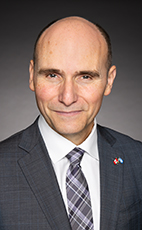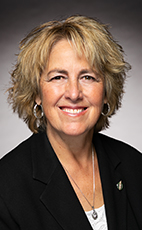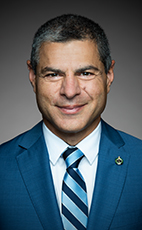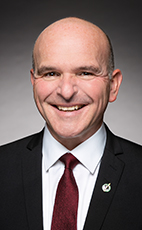44th Parl. 1st Sess.
December 8, 2021 02:00PM
- Dec/8/21 9:30:50 p.m.
- Watch
Madam Chair, I am happy to hear a mention of the election, since I did not see anything in the Conservatives' platform on—
24 words
- Hear!
- Rabble!
- add
- star_border
- share
- Dec/8/21 9:30:57 p.m.
- Watch
3 words
- Hear!
- Rabble!
- add
- star_border
- share
- Dec/8/21 9:30:59 p.m.
- Watch
Madam Chair, I repeat my question. How old did Canadians need to be to receive the $500?
17 words
- Hear!
- Rabble!
- add
- star_border
- share
- Dec/8/21 9:31:05 p.m.
- Watch
Madam Chair, in our platform, the age is 65 for the increase in the guaranteed income supplement—
19 words
- Hear!
- Rabble!
- add
- star_border
- share
- Dec/8/21 9:31:11 p.m.
- Watch
3 words
- Hear!
- Rabble!
- add
- star_border
- share
- Dec/8/21 9:31:13 p.m.
- Watch
Madam Chair, everyone aged 65 and over received $500. Is that what the minister is telling me?
18 words
- Hear!
- Rabble!
- add
- star_border
- share
- Dec/8/21 9:31:19 p.m.
- Watch
Madam Chair, it is a little more complicated, because our platform included numerous measures for seniors. It is obviously a little more straightforward if we look at—
28 words
- Hear!
- Rabble!
- add
- star_border
- share
- Dec/8/21 9:31:25 p.m.
- Watch
3 words
- Hear!
- Rabble!
- add
- star_border
- share
- Dec/8/21 9:31:26 p.m.
- Watch
Madam Chair, I repeat my question. At what age are Canadians considered seniors and eligible for government assistance? Is it from the age of 60, 65 or 70?
28 words
- Hear!
- Rabble!
- add
- star_border
- share
- Dec/8/21 9:31:37 p.m.
- Watch
Madam Chair, my colleague said earlier that people are already seniors at age 60. It is more a state of mind. I do not think—
26 words
- Hear!
- Rabble!
- add
- star_border
- share
- Dec/8/21 9:31:47 p.m.
- Watch
3 words
- Hear!
- Rabble!
- add
- star_border
- share
- Dec/8/21 9:31:49 p.m.
- Watch
Madam Chair, I repeat my question. The cost of living has skyrocketed for Canadians. What concrete action will the government take to change this situation and help them?
28 words
- Hear!
- Rabble!
- add
- star_border
- share
- Dec/8/21 9:32:03 p.m.
- Watch
Madam Chair, we will continue to invest in Canadians by reducing child care costs. With the Canada child benefit, we will make—
23 words
- Hear!
- Rabble!
- add
- star_border
- share
- Dec/8/21 9:32:14 p.m.
- Watch
Madam Chair, the government is spending $7.4 billion and is unable to tell me what, exactly, will be done to help seniors, families and the poor. I will repeat my question one last time because I just have a few seconds.
Can you tell me what concrete action you will take to improve quality of life and lower costs for all Canadians?
64 words
- Hear!
- Rabble!
- add
- star_border
- share
- Dec/8/21 9:32:31 p.m.
- Watch
I would ask the member to address his comments through the Chair.
The hon. Minister of Health.
17 words
- Hear!
- Rabble!
- add
- star_border
- share
- Dec/8/21 9:32:39 p.m.
- Watch
Madam Chair, we have already gone over this many times in earlier answers. I obviously do not have enough time to repeat what has been said. We spoke about the Canada child benefit, the guaranteed income supplement, old age security, the increases that are already in place and the ones that were announced during the election campaign.
57 words
- Hear!
- Rabble!
- add
- star_border
- share
- Dec/8/21 9:33:04 p.m.
- Watch
Madam Chair, before I begin, I would like to say it is wonderful to see you back in the chair again. I want to acknowledge that I am speaking from the unceded territory of the Algonquin people. I will be speaking on the topic of residential schools.
Many indigenous people in this country either went to or had family attend a residential school. It is essential to listen to indigenous people's experiences from all over the country. We must move away from paternalistic and discriminatory practices. With the knowledge and wisdom of elders, families and indigenous leaders across the country advising and guiding us, my hope is that we are on the right path. The recognition of the duty to honour indigenous rights will keep steadily flowing through Canada, bringing out a more fair and equitable society for us all.
The schools' legacy haunts the present. It has affected indigenous communities over the long term, leading to significant gaps between indigenous and non-indigenous people. We continue to work with partners on addressing these gaps and putting an end to the ongoing negative impacts of colonialism. The location of unmarked graves at former residential school sites across Canada are tragic reminders of the mistreatment of indigenous children. Our thoughts are with those indigenous children who are missing and who never returned home, and with the survivors, families and communities as they mourn and heal.
I would like to take this opportunity to give some background on the history of residential schools and their ongoing impacts. Canada had a system of residential schools, starting from the 1830s until the last school closed in 1998. The aim of the schools was to assimilate indigenous children and erase their indigenous identities. These schools caused intergenerational trauma, which has long-term, negative impacts for indigenous people and communities.
Survivors of the system organized a class action lawsuit in the 2000s. The lawsuit, as well the research from the Royal Commission on Aboriginal Peoples, brought even more attention to the issue of abuse in the residential school system. In 2006, the Indian Residential Schools Settlement Agreement was signed. It established a multi-billion-dollar fund to assist former students and their families on their healing journey. As part of this agreement, the government also launched a national Truth and Reconciliation Commission.
I visited the Mohawk residential school located near me in Brantford. The students there referred to it as the “mush hole” because of the mush they were served to eat. It operated from 1831 to 1970. This former residential school, now known as the Woodland Cultural Centre, received federal funding from the investing in Canada infrastructure program in the amount of $7.6 million in July of this year. I was pleased to attend the announcement, which completed phase three of the centre's fundraising and moved it one step closer to its goal of becoming a cultural heritage site.
This past summer I joined the “Walk for Joe” on its journey from the Mohawk Institute to Pikwakanagan First Nation. Joe and Rocky Commanda were removed from their home in the mid-1960s and taken to the Mohawk Institute. The brothers ran away twice in an attempt to get home. On their second attempt, they got separated. On September 13, 1968, Joe, only 13 at the time, was struck and killed by a train in Oakville, Ontario. Rocky, who joined the walk this summer, was a year older and was apprehended by police and put in a Toronto jail. This story of Joe and Rocky is sadly not unique.
In its final report, the commission laid out an important question: Now that we know about residential schools and their legacy, what do we do about it? The commission provided a way to reconcile with the hard truths of the past. In its summary report, it provided 94 calls to action urging various governments and key players to repair the harms caused by residential schools. These calls to action have given us a foundation guiding our government and partners as we work to address the injustices of colonialism and advance reconciliation.
With a better understanding of the harm and the ramifications of the residential schools for indigenous communities today, we must move forward with action to drive change, led by indigenous people. One of the most concrete tools that we have to address the past and positively affect the present and the future is by fully implementing the calls to action from the Truth and Reconciliation Commission. There are 94 calls to action, which ask all levels of government, educational and religious institutions, civil society groups and Canadians to take action toward reconciliation.
They are comprehensive and require effort from a variety of stakeholders to work with indigenous partners on a new type of relationship: one that is based on respect and recognition of rights. Issues that the calls to action address include child welfare, education, language and culture, commemoration, health, missing children and burial information, justice and many others.
Our government committed to fully implementing the changes recommended by the calls to action. We have made progress, but we recognize there is much more work required. Of the 76 calls to action that are the responsibility, or shared responsibility, of the federal government, 80% have been completed or are well under way.
We have made great strides in areas such as education, where we codeveloped improved funding models and supported full-day kindergarten programs in first nations schools. On language, we have funded language preservation and appointed a commissioner of indigenous languages. On commemoration, we have legislated the National Day for Truth and Reconciliation and provided funding for a national monument commemorating the legacy of residential schools. I was pleased to work with Commissioner Marie on that monument.
There are many other things we have done, but I have questions for the Minister of Crown-Indigenous Relations.
This year was the sixth anniversary of the release of the Truth and Reconciliation Commission's calls to action, which called on government, educational and religious institutions, civil society and all Canadians to take action on the 94 calls to action laid out in the truth and reconciliation report.
In September, on Orange Shirt Day, many Canadians made personal commitments to the calls to action. In the six years since the release of the final report, what progress has the federal government made on the calls to action that fall under the purview of the Government of Canada?
Could the minister please provide an update on the status of the government's actions to date to implement the truth and reconciliation calls to action?
1112 words
All Topics
- Hear!
- Rabble!
- add
- star_border
- share
- Dec/8/21 9:40:32 p.m.
- Watch
Madam Chair, I want to take the opportunity to thank the member for the incredible work she has done as my parliamentary secretary and wish her all the best in her new role as the Parliamentary Secretary for Public Safety.
Most notable, in light of what we have all seen over the last four months with the devastating discoveries and rediscoveries of unmarked graves and with more to come, is the sobering realization about the pace of this progress. As a part of that reaction, our government has committed $320 million to accelerate the pace, particularly with calls to action 72 through 76, which are about getting to the truth of this and continuing to get to the truth of this, because it does come before reconciliation. We are working with communities to support them in their quest for truth at their pace and on their conditions.
With those sums, I am happy to report that over a couple of dozen projects have been funded, with many more to come. In that light, Canadians need to brace themselves for the discovery of more findings and more reckoning, with the triggering and traumatization that has had a ripple effect on all indigenous communities. However, it is something for which we have to walk with communities, in respect and at their pace.
220 words
All Topics
- Hear!
- Rabble!
- add
- star_border
- share
- Dec/8/21 9:41:44 p.m.
- Watch
Madam Chair, since the springtime discovery of the remains of 215 children on the grounds of the Kamloops Indian Residential School and then several other discoveries, including at Cowessess First Nation, we have heard about the emotional reaction of residential school survivors and how discoveries and searches across the country have been deeply traumatic for survivors, their families and indigenous communities. Many communities across the country have expressed a desire to also search for and commemorate lost children.
How will the government support this? Furthermore, how will the government support the mental health and well-being of communities during the process?
101 words
All Topics
- Hear!
- Rabble!
- add
- star_border
- share
- Dec/8/21 9:42:29 p.m.
- Watch
Mr. Chair, building on my previous answer, I had the opportunity over the course of the summer and the last few weeks to visit over half a dozen sites, each with its own unique, devastating story. However, throughout that, we have heard the cry from indigenous communities, from survivors and those who are courageously speaking out, but also from those who are courageously still suffering in silence, regarding the mental health supports in communities. It has had a ripple effect in every single community in Canada. The $320 million that was announced by the Prime Minister in June comprises a portion of about $100 million for mental health supports in communities.
We will continue to be there with communities again, at their pace, to support them through this difficult time.
130 words
All Topics
- Hear!
- Rabble!
- add
- star_border
- share
- menumenu
- notificationsnotifications
- home
- mailmail
- searchsearch








